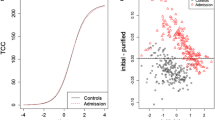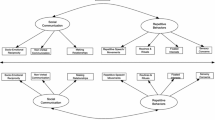Abstract
Retest stability of DSM-III-R diagnoses was assessed using the DISC-2.1C with a sample of Anglo, African, and Hispanic American adolescent patients 12 to 17 years of age. Based on the kappa statistic, retest stability was fair for any disorder (κ =.50), for any anxiety disorder (κ =.44), for any affective disorder (κ =.53), for any disruptive behavior disorder (κ =.58), and for substance use disorders (κ =.46). Although there was a trend for reliability to be somewhat higher for African Americans (κ =.58) than for Anglos (κ =.42) or Hispanics (κ =.49), these differences were not statistically significant. In general, 15- to 17-year-olds had somewhat better reliability (κ =.58) than did 12- to 14-year-olds (κ =.44). Males had somewhat higher reliability (κ =.63) than females (κ =.43). These findings are congruent with those reported recently using the DISC-R (Schwab-Stone et al., 1993) and suggest that the DISC appears to be at least as reliable as other available child diagnostic instruments. In view of the fair-to-moderate levels of reliability of these instruments in general, future research should focus on the joint effects of instrument, subject, interviewer, and nomenclature on operating characteristics of diagnostic interview schedules, focusing in particular on factors affecting accurate recall and reporting of symptoms and episodes.
Similar content being viewed by others
References
American Psychiatric Association. (1980).Diagnostic and statistical manual of mental disorders (3rd ed.). Washington, DC: Author.
American Psychiatric Association. (1987).Diagnostic and statistical manual of mental disorders (3rd ed., rev.). Washington, DC: Author.
American Psychiatric Association. (1994).Diagnostic and statistical manual of mental disorders (4th ed.). Washington, DC: Author.
Aneshensel, C. S., Estrada, A. L., Hansell, M. J., & Clark, V. A. (1987). Social psychological aspects of reporting behavior: Lifetime depressive episode reports.Journal of Health and Social Behavior, 28 232–246.
Bromet, E. J., Dunn, L. O., Connell, M. M., Dew, M. A., & Schulberg, H. C. (1986). Longterm reliability of diagnosing lifetime major depression in a community sample.Archives of General Psychiatry, 43, 435–440.
Chambers, W., Puig-Antich, J., Hirsch, M., et al. (1985). The assessment of affective disorders in children and adolescents by semistructured interview: Test-retest reliability of the Schedule for Affective Disorders and Schizophrenia for school-aged children. Present Episode Version.Archives of General Psychiatry, 42 696–702.
Cohen, J. (1960). A coefficient of agreement for nominal scales.Educational and Psychological Measurement, 20 37–46.
Costello, E. J., Burns, B. J., Angold, A., & Leaf, P., Jr. (1993). How can epidemiology improve mental health services for children and adolescents?Journal of American Academy of Child and Adolescent Psychiatry, 32 1106–1113.
Costello, E. J., Edelbrock, C., & Costello, A. J. (1985). The validity of the NIMH Diagnostic Interview Schedule for Children: A comparison between pediatric and psychiatric referrals.Journal of Abnormal Child Psychology, 13 579–595.
Costello, A. J., Edelbrock, C., Duncan, M. K., Kalas, R., & Klaric, S. H. (1984).Development and testing of the NIMH Diagnostic Interview Schedule for Children in a clinic population. Final Report (Contract No. RFP-DB-81-0027). Rockville, MD: Center for Epidemiologic Studies, National Institute of Mental Health.
Edelbrock, C., & Costello, A. J. (1988). Structured psychiatric interviews for children. In M. Rutter, A. H. Tuma, & I. S. Lann (Eds.),Assessment and diagnosis in child psychopathology (pp. 87–112). New York: Guilford Press.
Fisher, P., Shaffer, D., Piacentini, J., et al. (1993). Sensitivity of the Diagnostic Interview Schedule for Children, 2nd Edition (DISC-2.1) for specific diagnosis of children and adolescents.Journal of American Academy of Child and Adolescent Psychiatry, 32, 666–673.
Fleiss, J. L., Cohen, J., & Everitt, B. S. (1969). Large sample standard errors of kappa and weighted kappa.Psychological Bulletin, 72 323–327.
Gutterman, E. M., O'Brien, J. D., & Young, J. G. (1987). Structured diagnostic interviews for children and adolescents: Current status and future directions.Journal of American Academy of Child and Adolescent Psychiatry, 26 621–630.
Hodges, K., Cools, J., & McKnew, D. (1989). Test-retest reliability of a clinical research interview for children: The Child Assessment Schedule.Psychological Assessment: A Journal of consulting and Clinical Psychology, 1 317–322.
Jobe, J. B., & Mingay, D. J. (1989). Cognitive research improves questionnaires.American Journal of Public Health, 79 1053–1055.
Jorm, A. F., Duncan-Jones, P., & Scott, R. (1989). An analysis of the re-test artefact in longitudinal studies of psychiatric symptoms and personality.Psychological Medicine, 19 487–493.
Landis, J. R., & Koch, G. G. (1977). The measurement of observer agreement for categorical data.Biometrics, 33 159–174.
Lavigne, J. V., Arend, R., Rosenbaum, D., Sinacore, J., et al. (1994). Interrater reliability of the DSM-III-R with preschool children.Journal of Abnormal Psychology, 22 679–690.
Means, B., Nigam, A., Zarrow, M., Loftus, E. F., & Donaldson, M. S. (1989). Autobiographical memory for health-related events.Vital and Health Statistics, Series 6, No. 2.
McLeod, J. D., Turnbull, J. E., Kessler, R. C., & Abelson, J. M. (1990). Sources of discrepancy in a comparison of a lay-administered diagnostic instrument with clinical diagnosis.Psychiatry Research, 31 145–159.
Piacentini, J. C., Shaffer, D., Fisher, P., Schwab-Stone, M., Davies, M., & Gioia, P. (1993). The Diagnostic Interview for Children—Revised Version (DISC-R): III. Criterion validity.Journal of American Academy of Child and Adolescent Psychiatry, 32 658–665.
Roberts, R., Lewinsohn, P. M., & Seeley, J. R. (1993). A brief measure of loneliness suitable for use with adolescents.Psychological Reports, 72 1379–1391.
Roberts, R. E., Vernon, S. A., & Rhodes, H. M. (in press). Effects of language and ethnic status on reliability and validity of the DIS.Research in Community and Mental Health.
Robins, L. H., Helzer, J. E., Croughan, J., & Ratcliff, K. S. (1981). National Institute of Mental Health Diagnostic Interview Schedule: Its history, characteristics, and validity.Archives of General Psychiatry, 38 393–398.
Rutter, M., Tuma, A. H., & Lann, I. S. (Eds.). (1988).Assessment and diagnosis in child psychopathology. New York: Guilford Press.
Schwab-Stone, M., Fisher, P., Piacentini, J., et al. (1993). The Diagnostic Interview Schedule for Children—Revised Version (DISC-R): II. Test-retest reliability.Journal of American Academy of Child and Adolescent Psychiatry, 32 651–657.
Schwartz-Gould, M., & Wunsch-Hitzig, R. (1981). Estimating the prevalence of childhood psychopathology.Journal of the American Academy of Child Psychiatry, 20 462–476.
Shaffer, D. (1993). Discussion of “How can epidemiology improve mental health services for children and adolescents?”Journal of American Academy of Child and Adolescent Psychiatry, 32 1114–1115.
Shaffer, D., Schwab-Stone, M., Fisher, P., et al. (1993). The Diagnostic Interview for Children—Revised (DISC-R): I. Preparation, field-testing, interrater reliability, and acceptability.Journal of American Academy of Child and Adolescent Psychiatry, 32 643–650.
Shrout, P. E., & Fleiss, J. L. (1979). Intraclass correlations: Uses in assessing rater reliability.Psychological Bulletin, 2 420–428.
Tanur, J. M. (Ed.). (1991).Questions about questions. New York: Russell Sage Foundation.
Welner, Z., Reich, W., Herjanic, B., Jung, K., & Amado, H. (1987). Reliability, validity, and parent-child agreement studies of the Diagnostic Interview for Children and Adolescents (DICA).Journal of American Academy of Child and Adolescent Psychiatry, 26 645–653.
Young, J. G., O'Brien, J. D. Gutterman, E. M., & Cohen, P. (1987). Research on the clinical interview.Journal of American Academy of Child and Adolescent Psychiatry, 26 613–620.
Author information
Authors and Affiliations
Additional information
This research was supported in part by grants MH44214 and MH44773 from the National Institute of Mental Health, and by the Hogg Foundation for Mental Health. The authors wish to acknowledge the participation and collaboration of A. J. Pumariega, J. W. Swanson, and C. E. Holzer III and staff of the Center for Cross-Cultural Research, directed by F. M. Treviño.
Rights and permissions
About this article
Cite this article
Roberts, R.E., Solovitz, B.L., Chen, YW. et al. Retest stability of DSM-III-R diagnoses among adolescents using the diagnostic interview schedule for children (DISC-2.1C). J Abnorm Child Psychol 24, 349–362 (1996). https://doi.org/10.1007/BF01441635
Received:
Issue Date:
DOI: https://doi.org/10.1007/BF01441635




